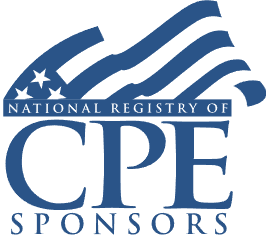Deemed Repatriation of Deferred Foreign Earnings: Calculating Accumulated E&P and Transition Tax
Determining U.S Shareholders, Cash vs. Non-Cash Positions, Netting Provisions, and Mechanics of Reporting Repatriation Tax

Course Details
- smart_display Format
On-Demand
- signal_cellular_alt Difficulty Level
Intermediate
- work Practice Area
Accounting
- event Date
Wednesday, February 21, 2018
- schedule Time
1:00 PM E.T.
- timer Program Length
110 minutes
-
BARBRI is a NASBA CPE sponsor and this 110-minute webinar is accredited for 2.0 CPE credits.
-
BARBRI is an IRS-approved continuing education provider offering certified courses for Enrolled Agents (EA) and Tax Return Preparers (RTRP).
-
Live Online
On Demand
This course will provide tax advisers with a practical guide to the deemed repatriation provisions of the new tax reform bill, with a focus on the specific compliance aspects of the requirement to recognize all post-1986 deferred foreign source income. The panel will go beyond the basics of what the law says to present compliance professionals with a detailed focus on calculations and the nuts-and-bolts of repatriation, including the leg-work of determining whether a client/entity qualified as a “U.S. shareholder” under the new definitions.
Description
The “deemed repatriation” provisions of the tax overhaul law present tax advisers to U.S. taxpayers engaged in foreign business and investment activities with an almost immediate compliance challenge. These deemed repatriation provisions, changes to the definition of who is a U.S. shareholder, and changes in attribution rules to determine CFC status, will impact 2017 filings. Tax advisers need to immediately grasp the details of the new provisions to avoid costly tax consequences for their clients engaged in cross-border activities.
The new law requires “U.S. shareholders” of “specified foreign corporations” (SFCs) to report and pay a one-time “transition tax” on previously untaxed accumulated E&P. These SFCs include all foreign entities qualifying as CFCs as well as other foreign corporations. For purposes of the new foreign tax regime, U.S. shareholder includes any U.S. domestic corporation, partnership, trust, estate or individual that directly, indirectly or constructively owns 10% or more of an SFC’s value or voting power. This represents a change in the type of taxpayer that must report foreign income.
The bill imposes separate rates for accumulated cash vs. non-cash retained E&P amounts, with cash positions subject to a higher rate. The law also allows taxpayers to net certain E&P positions, and to claim a percentage of foreign taxes attributable to the accumulated E&P, again at separate rates.
Listen as our expert panel provides a thorough and practical guide to the mechanics of identifying, calculating and reporting this transition tax under the deemed repatriation provisions of the tax overhaul bill.
Outline
- U.S. shareholders subject to new foreign provisions
- Definition of “specified foreign corporations”
- Identifying and calculating accumulated E&P subject to deemed repatriation transition tax
- Cash positions
- Non-cash positions
- Netting provisions
- Exclusion for E&P accumulated prior to CFC/SFC status or U.S. shareholder status
- Areas awaiting IRS regulatory guidance
- Calculating tax
- Rates for cash positions
- Rates for non-cash positions
- Calculating eligible foreign tax credits
Benefits
The panel will discuss these and other important topics:
- What differences in definition of U.S. shareholders and specified foreign corporations are included in the new law from prior provisions?
- Identifying what is included in cash and non-cash accumulated E&P positions
- Netting provisions
- What areas and issues will require IRS regulatory guidance?
NASBA Details
Learning Objectives
After completing this course, you will be able to:
- Establish the new repatriation provisions governing deferred foreign earnings.
- Identify what is included in calculating earnings and profits.
- Recognize the tax advantages of the “netting provisions.”
- Determine whether installment payment of repatriation tax is beneficial.
- Distinguish controlled foreign corporations and specified foreign corporations.
- Ascertain areas of the new law’s tax provisions that would benefit from further IRS guidance.
- Field of Study: Taxes
- Level of Knowledge: Intermediate
- Advance Preparation: None
- Teaching Method: Seminar/Lecture
- Delivery Method: Group-Internet (via computer)
- Attendance Monitoring Method: Attendance is monitored electronically via a participant's PIN and through a series of attendance verification prompts displayed throughout the program
- Prerequisite:
Three years+ business or professional experience at mid-level within the organization, preparing complex tax forms and schedules. Specific knowledge and understanding of international taxation, deferred foreign-source income, earnings and profits, controlled foreign corporations, specified foreign corporations, and repatriation of deferred foreign earnings; familiarity with accumulated cash and non-cash retained earnings and profits and netting of earnings and profits positions.

Strafford Publications, Inc. is registered with the National Association of State Boards of Accountancy (NASBA) as a sponsor of continuing professional education on the National Registry of CPE Sponsors. State boards of Accountancy have final authority on the acceptance of individual courses for CPE Credits. Complaints regarding registered sponsons may be submitted to NASBA through its website: www.nasbaregistry.org.

Strafford is an IRS-approved continuing education provider offering certified courses for Enrolled Agents (EA) and Tax Return Preparers (RTRP).
Unlimited access to premium CLE courses:
- Annual access
- Available live and on-demand
- Best for attorneys and legal professionals
Unlimited access to premium CPE courses.:
- Annual access
- Available live and on-demand
- Best for CPAs and tax professionals
Unlimited access to premium CLE, CPE, Professional Skills and Practice-Ready courses.:
- Annual access
- Available live and on-demand
- Best for legal, accounting, and tax professionals
Unlimited access to Professional Skills and Practice-Ready courses:
- Annual access
- Available on-demand
- Best for new attorneys
Related Courses

Privacy Class Actions Post-Spokeo: Leveraging Injury-In-Fact Requirements
Available On-Demand

New Amendments to Federal Rule 23: Impact on Class Action Practice
Available On-Demand
Recommended Resources
Gain a Competitive Edge Through Efficient CPE Strategies
- Learning & Development
- Business & Professional Skills
- Career Advancement